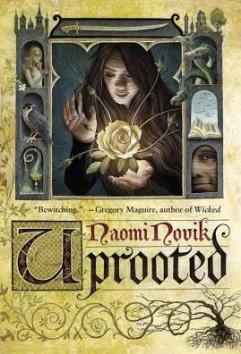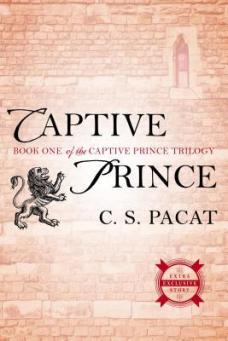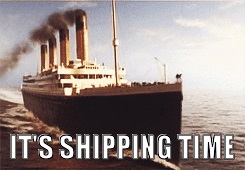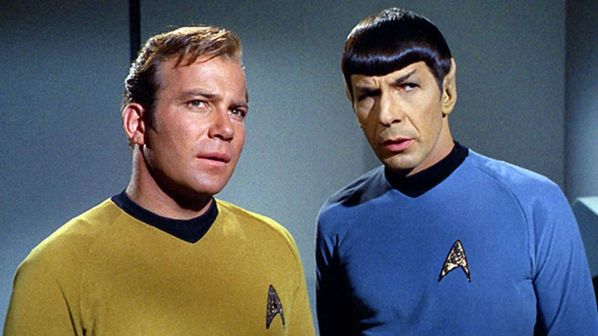There was an unsuspecting evolution that led to me reading a work of male/male original slash fiction.
It started when an online friend of mine recommended a book to me through Goodreads: Uprooted – a beautifully written, dark fantasy fairytale by Naomi Novik.
My friend I discussed this book extensively via Goodreads as I read it, and when I finished, I suggested we next read the same book simultaneously so we could discuss our reactions to it in real time.
The book we decided to buddy read was the popular YA fantasy A Court of Thorns and Roses by Sarah J. Maas.
Both Uprooted and ACOTAR had two things in common. Firstly, the plots of both involved a girl being taken captive by a man: in Uprooted, this man was a wizard and in ACOTAR, a high lord of the Fae.
The second commonality – the thing that left me ripe for something different when the opportunity for such eventually presented itself – was that in both cases, the men didn’t harm these captured girls at all – not physically, emotionally, or sexually.
 There was not even a hint of the likely danger such a situation would entail for a real woman under similar circumstances.
There was not even a hint of the likely danger such a situation would entail for a real woman under similar circumstances.
“Benevolent captivity”, my friend termed it when I complained to her about it.
To be clear, I don’t enjoy stories about women being abused. But I do like the books I read to be realistic, even when they are fantasy books.
I believe that art should either imitate life or recreate it entirely. In both these books, every other aspect of the story world was thoroughly gendered: women required dowries for marriage; respectable women solely wore dresses; men held traditionally masculine jobs; there were no legitimate female rulers or leaders.
This benevolent captivity premise felt even more affected given, in both books, a romantic relationship developed between captor and captee – a fact I’m fairly certain required no spoiler alert.
By the end of my buddy reading experience, I told myself I was done with captured girl romances – that I’d never read another unless it brought something dramatically different to the table.
As the saying goes, seek and ye shall receive.
A princely premise
In this particular case, no active seeking on my part actually occurred.
 I’m not even sure how the book Captive Prince came to my attention. It was via a Goodreads “People Also Liked” list displayed on the sidebar of a search page – that much I can I recall.
I’m not even sure how the book Captive Prince came to my attention. It was via a Goodreads “People Also Liked” list displayed on the sidebar of a search page – that much I can I recall.
But with its unassuming cover and even more retiring abbreviated author name of C.S. Pacat, I’m at a loss as to remember what specifically about it made me click the link.
When I did, however, I found myself fascinated by a premise that was both similar and different to what I’d been reading of late.
In a fantasy world based on Ancient Greece, a prince is stripped of his identity by his usurping illegitimate brother and given as a pleasure slave to the crown prince of an enemy nation.
Well that, I thought, is definitely something different.
And interesting, for how would the captivity trope with all its discrepancies of power (and likewise, the inevitable romance) play out when both the abductor and abductee were the same gender, in this case, male?
Read it and find out, I told myself. Why not? I’ll try just about anything once.
Under full sail
This wasn’t actually my first exposure to male/male fiction (although it was the first novel-length work of it I’ve ever read, and definitely the first trilogy, of which I’m currently midway through book 3).
Male/male a very common feature of fan fiction, which I’ve occasionally read off and on for years, and which I’ve previously written about.
(Admittedly, most of the fanfic I’ve read has been within the Transformers fandom. This involves characters – giant autonomous robots – that are ostensibly genderless, for all that it’s extremely difficult to write with an agender lens. Gender is a special sauce in which we’ve all been socialized since birth until very well done.)
According to TV Tropes, most fan fiction is written by women. Ethnographic research suggests this is in response to the fact that female tastes and fantasies largely unfulfilled in male-dominated, mainstream media.
 A significant amount of fan fiction involves “shipping” – that is, taking two (or more) characters who aren’t a couple in the source material and putting them into a romantic (and often sexual) relationship.
A significant amount of fan fiction involves “shipping” – that is, taking two (or more) characters who aren’t a couple in the source material and putting them into a romantic (and often sexual) relationship.
Two of the oldest “ships” in the history of fandom are probably Kirk/Spock from the original Star Trek and Sherlock Holmes/Watson.
When a ship involves a same-sex pairing, it is referred to as “slash”, signifying the “/” that separates names of the shipped characters. “Slash” more specifically often refers to a male/male pairing, while female/female pairings are called “femslash”.
As previous mentioned, a significant proportion of fan fiction is comprised of male/male slash.
Another friend of mine, this one an offline pal, equates shipping to Fantasy Football.
/ ? (or, Why slash?)
Although it obviously draws inspiration from fandom, Captive Prince technically isn’t slash.
Slash involves placing pre-existing characters in a same-sex pairing in subversion of mainstream society’s larger heteronormative ideal.
To paraphrase the author herself, as a work of original fiction, the book was from the start conceived to feature a same-sex pairing. As such, there’s nothing outwardly subversive about it beyond its general existence amidst the dearth of same-sex pairings within traditional publishing.
I absolutely loved this book. For a story about a pleasure slave, it wasn’t particularly explicit. Or even overly sexual at all, which I’m never much into, regardless of the pairing.
More than anything, the book dealt with a host of succession politics and an illegitimate seizure of power, replete with all the court drama, scheming, double-crossing, backstabbing, and swordfighting inherent in such a storyline.
All the stuff I love (and incidentally am currently writing about myself) in historical and historically-inspired genres.
But I surprised myself by loving the male/male pairing as well.
I’ve often wondered why so much fan fiction contains slash pairings – why it is the predominantly female readers and writers of the stuff like that feature so much. Outwardly, I suppose it makes sense: if one is a heterosexual woman, if one man is good, than two should be even better.
In my own case, my enjoyment wasn’t quite owing to anything so prurient (not quite…).
Rather, it was the way in which, despite literally being in chains, getting beaten up, lashed, and subjected to a number of sexual indignities, the captive prince didn’t seem entirely disempowered. Not when all that befell him had more to do with the role he filled (a slave) than any fundamental facet of who he was as a person.
A world I want to know
In stories where women are victimized by men, as in real life, the violence comes to bear with centuries’ worth of gender-based violence, institutional marginalization, and societal disdain, all of which, in part, still exists to this day.
 In stories where this marginalization is conveniently omitted from an otherwise unequal world, its absence hovers like a phantom limb. It does nothing to simulate an ideal world as it could be, but instead is as noticeable as yet another gender-based slur, exclusion, or wanton act of violence.
In stories where this marginalization is conveniently omitted from an otherwise unequal world, its absence hovers like a phantom limb. It does nothing to simulate an ideal world as it could be, but instead is as noticeable as yet another gender-based slur, exclusion, or wanton act of violence.
Men can be victimized too in society, although this most often occurs at the hands of other men, and is usually not for being a man in and of itself. Men are usually targeted for being a certain type of man – a black man, a gay man, a Muslim man, a man possessing too many qualities that are deemed feminine in nature.
Women, meanwhile, are often targeted for the very fact that they are women. Women also often feel like a captive trying to navigate the varied and numerous male-dominated institutions in mainstream society.
And so, in reading this slash series – my third story premised on kidnapping in the past two months – I found myself unexpectedly and blissfully liberated from much of the societal baggage and unequal gender power dynamics that are inherent in a plotline such as this.
The two main characters felt as close to equal as one of them being a slave made possible. This gave me the freedom to identify with whichever one I chose, and while do so, to enjoy a vicarious experience of a world untouched of the long shadow of gender inequality.
Which is the very thing fiction does best: transporting us to worlds we’ve never known in hopes that we can someday make that fantasy a reality.
How far are you able to suspend your disbelief in fiction? Do elements of the real world ever intrude upon your reading experiences? Have you ever read any type of slash fiction? Tell me about it in the comments.
A/N: There will be no new post on Victoria Day next Monday. Happy May 2-4 long weekend to all my fellow Canadians!
(Image source #1, #2, #3, #4, and #5)


I just love how you get me thinking about things from a viewpoint I wouldnt automatically consider. Thanks for shaking up my default and expanding my reading list!!
LikeLike
Awesome! Glad you liked it. Happy reading. 🙂
LikeLiked by 1 person
I’ll suspend my disbelief as far as I have to for a good story, provided the universe stays consistent. Breakfast of Champions by Kurt Vonnegut breaks the fourth wall like no other third-person book I’ve read, but it fits the surreal nature of the story. On the other hand, a British mystery set in the 1920s at a country manor is better off avoiding characters and events that belong in a different type of universe (unless of course it is a parody or experimental somehow).
That said, assuming a story follows its own rules, I prefer that it doesn’t pull punches. Go big or go home. Don’t write from the perspective of “Well, this wouldn’t really happen” or “There’s no way this character could pull that off in one try.” Those scenes are the ones people talk about later.
I’ve never read slash fiction but the concept intrigues me from a sociological standpoint. Sorry if this is a bit “real” for your comment section, but in the adult-entertainment word, “girl-on-girl” subject matter targeted at hetero males has been a staple for decades, whereas there is no corresponding “male-on-male” sub-genre targeted at hetero women (that I know of). From my experience, whenever this subject areas has been broached in mixed company, women in my age group (Gen X, in other words) have expressed active disinterest and even repulsion toward the idea of watching two men engaged in romantic/sexual acts (they were not repulsed by the idea of men being gay, just the idea of women watching and enjoying men doing it).
However, I have talked to several millennial-age women who think slash fiction and the general idea of two attractive men going at it is, if I may boil it down to the most base element, “hot.”
I wonder if younger women are more open/less conditioned against it, if there are some other societal factors I am not considering, or if it’s just coincidence because my sample is too small.
LikeLike
I agree with you: the internal consistency of the story world is key. I don’t expect stories to perfectly mirror the real world – in fact, I prefer that they don’t, which is the reason I almost never read contemporary genres, instead preferring historical and speculative books. However, I do find that internal consistency is often easier to violate than an author realizes – that effective worldbuilding takes more painstaking effort than merely removing those aspects we dislike about modern society yet making no changes to the broader underpinnings that cause them.
I agree also that going big or going home is usually best, so long as there has been sufficient buildup and character development for the event in question rather than it reeking of deus ex machina.
As for slash fiction, I too find it a fascinating sociological concept. No worries about being too real for my blog, especially when I’m the one who broached the subject. “Girl-on-girl” is indeed the standard for the presumed straight male (i.e. the media default) viewer. Male/male or even just male nudity is virtually nonexistent in network broadcasting because, according to the media standards guidelines, doing so would automatically up the content rating of the program, which means few people will watch it and it will make less money. Beyond monetary concerns, though, I’m pretty sure I don’t need to explain why male nudity is treated so much more sacredly than female nudity. Can’t have women getting their thrills looking at undressed guys, after all.
Male/male is related to this point. Aside from a larger societal disdain for male homosexuality (although this is slowly changing), there is the fact that some women do indeed find it hot, regardless of what they’ll admit to in mixed company. Women’s sexuality and sexual expression receives so much scrutiny and judgement in mainstream society, it can make an admission of finding male/male a turn-on fraught. And this is assuming that a negative answer was fully deliberated upon – that the woman gave herself permission to thoroughly consider the question instead of automatically falling victim to some form of the prevailing “nice girls don’t do that”.
With society becoming more sex-positive, what you observed in your informal survey could be owing to younger women feeling less hampered (both consciously and subconsciously) by certain societal expectations. Or on the contrary, it could be due to them feeling obligated to play into certain expectations. It would be an interesting question to study more formally.
LikeLiked by 1 person
This might be the highest quantity of words exchanged between us in which there is no disagreement!
On the point of what society is comfortable with regarding female sexuality… One of the interesting aspects of horror films post 1978 (the year “Halloween” came out) is a tendency toward female protagonists. I can’t think of any other general-audience genre for which that is the case. At the same time, you don’t get much male objectification in these films, but you certainly get a lot of female objectification.
However, a couple of years ago an otherwise forgettable film was released called “Texas Chainsaw 3D” that featured multiple gratuitous shots of the male hero (played by Trey Songz) working out and generally posing shirtless with the camera moving over his body much in the way that the camera would normally do for a female subject. I remember watching it thinking, “This movie sucks, but what’s happening right this minute is pretty fascinating.”
I’ve thought in recent years that if I ever directed a horror movie, every nude swimming scene, shower scene, undressing scene, whatever would be exclusively male. It would be simple to do, not requiring any invention whatsoever, yet it would be totally subversive.
LikeLike
You make it sound like we disagree all the time. I’d say that 95% of the time, we actually agree. We just tend to rationalize issues from different perspectives.
(That being said, I may be helping prove your point with this one, disagreeing about our disagreement. Very meta.)
What you describe in Texas Chainsaw 3D is indeed a rare phenomenon. Hollywood is notorious for its inability and/or unwillingness to shoot footage from the female gaze. A particularly notable example of this is with the Fifty Shades of Grey movie. Say what you want about that book and its merits or lack thereof, it was written as a female sexual fantasy, from a female point of view.
Yet according to a friend of mine who saw the movie (and from the various teaser bits I’ve seen myself), there are no shots of Christian Grey lounging seductively to excite the female passions. Certainly there’s no nudity of him, but neither are there any risqué shots either where if you tilt your head and squint just so you can maybe catch a quick glimpse of a little something something. You don’t get to see his face at the moment of climax, but of course we see this with Anna. Which, as a hetero woman watching an R-rated movie that supposed to be a female fantasy, I don’t really need to see, for there’s already enough of that in every other movie.
Further to this point, I read an interesting article recently which discussed (with examples) erotic imagery of men as drawn by both straight women and gay men. Ostensibly, one might think all the images would be similar since both sets of artists are sexually attracted to men. Yet the differences were notable: the female-drawn images did so much more with angles and shadows and impassioned facial expressions and for the most part featured the men’s entire bodies. Meanwhile, with the male-drawn images, it was like boom – hello Mr. Johnson! The focal point was definitely different than in what the women shot. The article also mentioned how Playgirl always had a larger readership of gay men than straight women, for this very same reason of overt focal point.
All of this being my extremely long-winded way of saying that if a producer is truly interested in creating media geared toward women, there needs to be women involved in every stage of its creation (and really, this should be happening anyway in creative industries).
LikeLiked by 1 person
I believe the demographic toward horror films has been trending female for the past two decades. You’d think the movie people people would get what you already plainly see, but it doesn’t seem to be the case.
I haven’t paid much attention to the 50 Shades phenomenon as it seems basically like neutered porn for the suburban shopping mall crowd. But now that you mention it, it is odd that the film seems to be more concerned with posing the woman in a fetishistic manner than with considering what the audience might want to see.
LikeLiked by 1 person